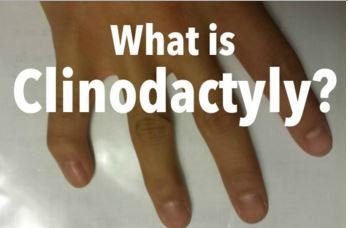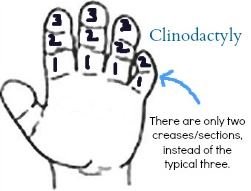Clinodactyly
What is clinodactyly?
Clinodactyly term is related with deformity of the little finger (the 5th finger of the hand). The fifth finger is bended towards ring finger (the 4th finger of the hand); this specific mal formation is termed as clinodactyly.
This term is derived from two Greek words, klinen means “to bend” and daktylos, means “finger”. Anatomically clinodactyly defined as a divergence of 5th finger in the radio-ulnar plane of the palm and keep away from the axis of epiphyseal joint which restrict the movement of flexion-extension.

Image 1 : Clinodactyly
Generally, this abnormality developed due to deformation of the middle bone of little finger and most of the cases are bilateral. The usual shape of the middle bone is rectangular, but in clinodactyly the bone of the little finger is underdeveloped and wedge-shaped. The development of clinodactyly may be associated with congenital malformation due to genetic disorder or external injury related.

Image 2: Description of Clinodactyly
Clinodactyly Pathology
Clinodactyly can occur due to congenital deformity or obtained at the latter stage of life (acquired). In case of acquired clinodactyly, the end of the middle bone of little finger becomes injured due to physical or thermal accidental incidence. In general, sporadic congenital abnormalities cause clinodactyly. Congenital clinodactyly often found in familial history.
Clinodactyly Genetics
Clinodactyly is an intermittent condition and can transfer this anomaly with generation to generation of an affected family. The usual familial passed down can be done by autosomal recessive inheritance. In autosomal recessive, the two abnormal copies of autosomal chromosomes are responsible for developing the disorder and one comes from paternal gene and another one is from maternal gene.
A mutation in a gene on one of the first 22 non-sex chromosomes can lead to an autosomal disorder. Family history is important to discover this familial transmission.
Clinodactyly Associations
The clinodactyly is associated with different genetic disorders which include Down syndrome, Cornelia de Lange syndrome, Aarskog syndrome, Klinefelter (XXY) syndrome, Carpenter syndrome, Seckel syndrome, Mohr syndrome and Russell-Silver syndrome.
Down syndrome is a congenital disorder take place due to genetic disorder associated with 21st chromosomal area. The resulting of this abnormality causes cognitive impairment and physical malformation including short physique and a wide facial shape.
Cornelia de Lange Syndrome is a chromosomal disorder present at the time of birth, but often it is not detected at that time. It leads to a range of physical and intellectual impairment for both the gender.
Aarskog syndrome arises because of mutational disorder in X-chromosome. This affects physical, facial, genital, muscular- skeleton structure of the body. This is an extremely rare syndrome and usually affects male children.
Klinefelter syndrome is a sex chromosomal disorder where more than one X chromosome is present in male and causes impotency. Maximum affected individuals are unaware of their abnormality.
Carpenter syndrome is a very rare congenital disorder and autosomal recessive means inherited disorder. The main features of this syndrome are- deformity in the cranium and the facial structure, fingers and toes are partially or fully united and obesity.
Seckel syndrome is characterised as dwarfism due to low birth weight due to neuro-developmental disorder.
Mohr syndrome is a type of autosomal recessive congenital disease, leads to cleft lip, multiple lobed tongue, absence of medial cutting teeth (incisors), and more than five fingers and toes in hands and feet.
Russell-Silver syndrome is an inheritance autosomal dominant disorder characterized by poor growth.
Clinodactyly Diagnosis
To diagnose the Clinodactyly is a thorough physical examination and knowledge of medical history is important. X- Ray helps to provide confirmation of the deformity. To discover the genetic involvement, genetic testing is useful to diagnose the affected regional area of chromosome.
Clinodactyly Management
Clinodactyly is not a frequently occurring anomaly almost 10% populations is affected by this type of deformity. This congenital deformity is more common in men than women. If the malformation is mild, then it’s not a serious health issue. Sometimes may cause mild pain or functional disturbance, but it does not interfere in normal daily activities. For this reason, usually surgery is not recommended.
Now a day’s female teenagers, are mostly feel it interfere their personal relationship, cosmetic correction procedure is available to correct this deformity. In this procedure, a conventional osteotomy is executed on the radial aspect of the middle phalanx for rectification of conventional delta phalanx.
Distractors enter through the opening of osteotomy and set inside the deformed epiphysis. Remain inside for 8 weeks, after that removed them and pursued by splintage to the fingers for 4 weeks. In the next step, active mobilization and night splintage are added for 4 weeks. The total correction duration is 12 weeks and the patient satisfaction level is very high.
Prognosis
The family related incidence of congenital clinodactyly more frequent. The number of reported cases is less than the incidence rate as a patient not required medical care due to minor anomaly, not causes difficulty to perform the daily activity or hamper the potentiality of the patient.
References
- http://www.ncbi.nlm.nih.gov/pmc/articles/PMC2594860/pdf/jnma00316-0071.pdf
- http://www.orthobullets.com/hand/6075/clinodactyly
- http://radiopaedia.org/articles/clinodactyly
- http://www.medicinenet.com/script/main/art.asp?articlekey=12233
- http://www.childrenshospital.org/conditions-and-treatments/conditions/clinodactyly/testing-and-diagnosis
- http://medind.nic.in/maa/t04/i3/maat04i3p227.pdf
